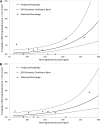Frequency of morning ketosis after overnight insulin suspension using an automated nocturnal predictive low glucose suspend system
- PMID: 24757229
- PMCID: PMC3994933
- DOI: 10.2337/dc13-2775
Frequency of morning ketosis after overnight insulin suspension using an automated nocturnal predictive low glucose suspend system
Abstract
Objective: To assess the effect of overnight insulin pump suspension in an automated predictive low glucose suspend system on morning blood glucose and ketone levels in an attempt to determine whether routine measurement of ketone levels is useful when a closed-loop system that suspends insulin delivery overnight is being used.
Research design and methods: Data from an in-home randomized trial of 45 individuals with type 1 diabetes (age range 15-45 years) were analyzed, evaluating an automated predictive low glucose pump suspension system in which blood glucose, blood ketone, and urine ketone levels were measured on 1,954 mornings.
Results: One or more pump suspensions occurred during 744 of the 977 intervention nights (76%). The morning blood ketone level was ≥0.6 mmol/L after 11 of the 744 nights (1.5%) during which a pump suspension occurred and 2 of the 233 nights (0.9%) during which there was no suspension compared with 11 of 977 control nights (1.1%). The morning blood ketone level was ≥0.6 mmol/L after only 2 of 159 nights (1.3%) with a pump suspension exceeding 2 h. Morning fasting blood glucose level was not a good predictor of the presence of blood ketones.
Conclusions: Routine measurement of blood or urine ketones during use of an automated pump suspension system using continuous glucose monitoring, whether threshold based or predictive, is not necessary. Recommendations for checking ketone levels should be no different when a patient is using a system with automated insulin suspension than it is for conventional diabetes self-management.
Figures
References
-
- Attia N, Jones TW, Holcombe J, Tamborlane WV. Comparison of human regular and lispro insulins after interruption of continuous subcutaneous insulin infusion and in the treatment of acutely decompensated IDDM. Diabetes Care 1998;21:817–821 - PubMed
-
- Castillo MJ, Scheen AJ, Lefèbvre PJ. The degree/rapidity of the metabolic deterioration following interruption of a continuous subcutaneous insulin infusion is influenced by the prevailing blood glucose level. J Clin Endocrinol Metab 1996;81:1975–1978 - PubMed
-
- Guerci B, Benichou M, Floriot M, et al. Accuracy of an electrochemical sensor for measuring capillary blood ketones by fingerstick samples during metabolic deterioration after continuous subcutaneous insulin infusion interruption in type 1 diabetic patients. Diabetes Care 2003;26:1137–1141 - PubMed
-
- Krzentowski G, Scheen A, Castillo M, Luyckx AS, Lefèbvre PJ. A 6-hour nocturnal interruption of a continuous subcutaneous insulin infusion: 1. Metabolic and hormonal consequences and scheme for a prompt return to adequate control. Diabetologia 1983;24:314–318 - PubMed
Publication types
MeSH terms
Substances
Grants and funding
LinkOut - more resources
Full Text Sources
Other Literature Sources
Medical


